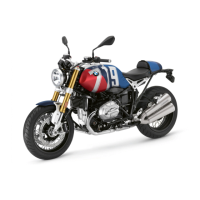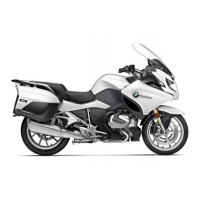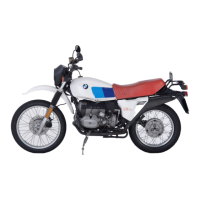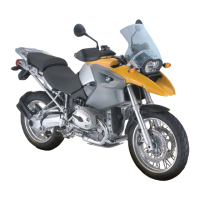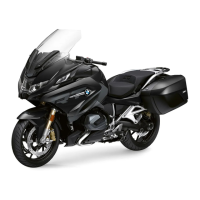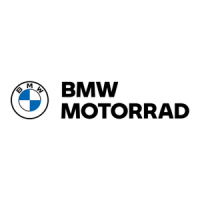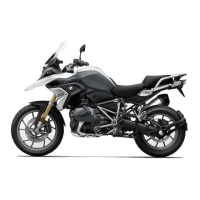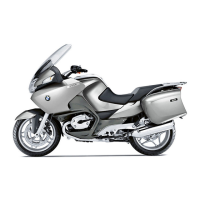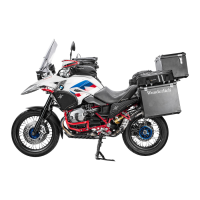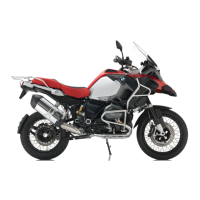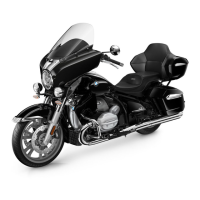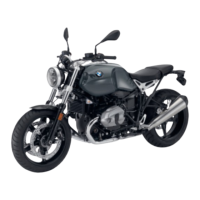
Do you have a question about the BMW Motorrad R nineT Pure and is the answer not in the manual?
| Brand | BMW Motorrad |
|---|---|
| Model | R nineT Pure |
| Category | Motorcycle |
| Language | English |
Provides a quick overview of the motorcycle and its key features for easy reference.
Explains common abbreviations and symbols used throughout the manual for clarity.
Details the motorcycle's standard and optional equipment for rider awareness.
Contains critical specifications and technical details of the motorcycle for reference.
Identifies main components and parts of the motorcycle from a left-side perspective.
Identifies main components and parts of the motorcycle from a right-side perspective.
Illustrates and identifies components located beneath the motorcycle's seat.
Details the functions and operation of the left-side handlebar control switches.
Details the functions and operation of the right-side handlebar control switches.
Explains the layout, indicators, and displays of the motorcycle's instrument cluster.
Explains the meaning and function of various indicator and warning lights on the instrument panel.
Details the information displayed on the motorcycle's multifunctional display screen.
Provides a visual guide to the motorcycle's indicator lights and their meanings.
Explains how the service due indicators and messages are displayed on the instrument cluster.
Instructions for using the ignition switch and locking the steering mechanism for security.
Explains the operation and safety function of the emergency-off switch.
Details on operating headlights, parking lights, hazard warning flashers, and turn signals.
Guide on selecting and viewing information on the instrument cluster's display.
How to adjust instrument cluster settings like display brightness, clock, date, and units.
Instructions for activating, deactivating, and understanding the anti-theft alarm system.
Explanation of how traction control systems work and how to turn them on or off.
How to select and use different riding modes (RAIN, ROAD, DYNA) to suit conditions.
Operation of the cruise control system for maintaining a set speed during rides.
Instructions on how to operate the heated grips for rider comfort in cold weather.
Procedures for removing and installing the rider's and passenger's seats.
Instructions for adjusting the motorcycle's mirrors for optimal visibility and positioning.
How to adjust the headlight beam throw and range for different riding conditions.
How to adjust the clutch lever position for rider comfort and control.
How to adjust the brake lever position for rider comfort and control.
How to adjust rear wheel spring preload based on load for optimal handling.
How to adjust suspension damping to suit road conditions and spring preload.
Instructions for adjusting the position of the footrest system for rider ergonomics.
Essential safety guidelines and precautions for riding the motorcycle safely.
A checklist of essential checks to perform before riding the motorcycle.
Step-by-step procedures for starting the motorcycle engine correctly.
Guidelines for the initial break-in period to ensure engine longevity and performance.
Information on achieving optimal braking performance and understanding brake system behavior.
Instructions for safely parking the motorcycle using the side stand and other precautions.
Guidance on recommended fuel quality, tank capacity, and the refueling process.
Detailed steps for securely lashing down the motorcycle for safe transport.
General introductory information about the motorcycle's technology.
Explanation of how the ABS system functions, including its benefits and limitations.
Details the Dynamic Brake Control system, its purpose, and behavior during riding.
Explains the operation of Traction Control systems (ASC/DTC) and their impact on riding.
How to select and use different riding modes (RAIN, ROAD, DYNA) to suit conditions.
Explanation of the Dynamic Engine Brake Control system and its role in stability.
Describes the function, activation conditions, and benefits of the adaptive headlight system.
General information and important notes regarding maintenance procedures and tools.
Lists and describes the contents and uses of the onboard vehicle toolkit.
Instructions for correctly attaching and using the BMW Motorrad front-wheel stand.
Instructions for correctly attaching and using the BMW Motorrad rear-wheel stand.
Procedures for checking the engine oil level and topping it up if necessary.
Guidance on checking brake function, pad wear, and fluid levels for safety.
How to check the clutch lever function and identify potential issues.
Procedures for checking tire pressure and tread depth for safe riding.
Instructions for checking the condition of the wheel rims and spokes.
Information on wheel sizes and their impact on motorcycle control systems.
Instructions on how to replace faulty LED light sources on the motorcycle.
Essential precautions and steps for safely jump-starting the motorcycle battery.
Maintenance instructions for the motorcycle battery to ensure its longevity and performance.
How to locate, replace, and understand the motorcycle's fuses.
Instructions for detaching and fastening the diagnostic socket for service access.
General notes regarding the use of accessories and products on the motorcycle.
Information on the USB charging socket's capabilities, usage, and auto-shutoff features.
Instructions for securely attaching and loading luggage onto the motorcycle.
Procedures for removing and installing the passenger frame assembly.
Information about available optional accessories and where to find further details.
Recommendations for using genuine BMW Motorrad cleaning and care products.
Detailed steps and tips for properly washing the motorcycle to maintain its appearance.
Guidance on cleaning delicate motorcycle parts like plastics and trim panels.
Procedures for washing, cleaning, and preserving the motorcycle's paint finish.
How to apply preservatives to maintain the paint's condition and water repellency.
Instructions for properly preparing and storing the motorcycle for extended periods.
Steps for preparing the motorcycle for use after it has been stored.
A guide to diagnosing and resolving common starting issues with the motorcycle.
Specifications for various threaded connections, including torque values.
Details on recommended fuel quality, tank capacity, fuel reserve, and consumption.
Information on engine oil capacity, specification, and procedures for topping up.
Key technical specifications of the motorcycle's engine, including displacement and power.
Technical details regarding the clutch design and transmission gear ratios.
Technical details regarding the transmission design and gear ratios.
Technical details about the final drive type and rear wheel guide system.
Technical specifications related to the motorcycle's frame design and identification.
Technical specifications for the front and rear suspension and chassis adjustment recommendations.
Technical specifications for the front and rear brake systems.
Specifications for wheels, rims, tires, and their designations.
Details on fuses, battery specifications, spark plugs, and light sources.
Physical dimensions of the motorcycle, including length, height, and width.
Specifications for the motorcycle's unloaded and gross vehicle weights, and maximum payload.
Information on the motorcycle's maximum speed capabilities.
Procedures for reporting safety-related defects to relevant authorities.
Information on authorized BMW Motorrad service centers and their capabilities.
Explains how maintenance work is recorded in the electronic service history.
Overview of BMW Motorrad's roadside assistance and breakdown services.
Details on pre-delivery checks and the BMW running-in check procedure.
A comprehensive schedule outlining required maintenance tasks by mileage and time intervals.
Specific repair procedures and checks required during the motorcycle's break-in period.
Forms for documenting and confirming completed maintenance work.
Forms for recording maintenance and repair work, optional accessories, and campaigns.
